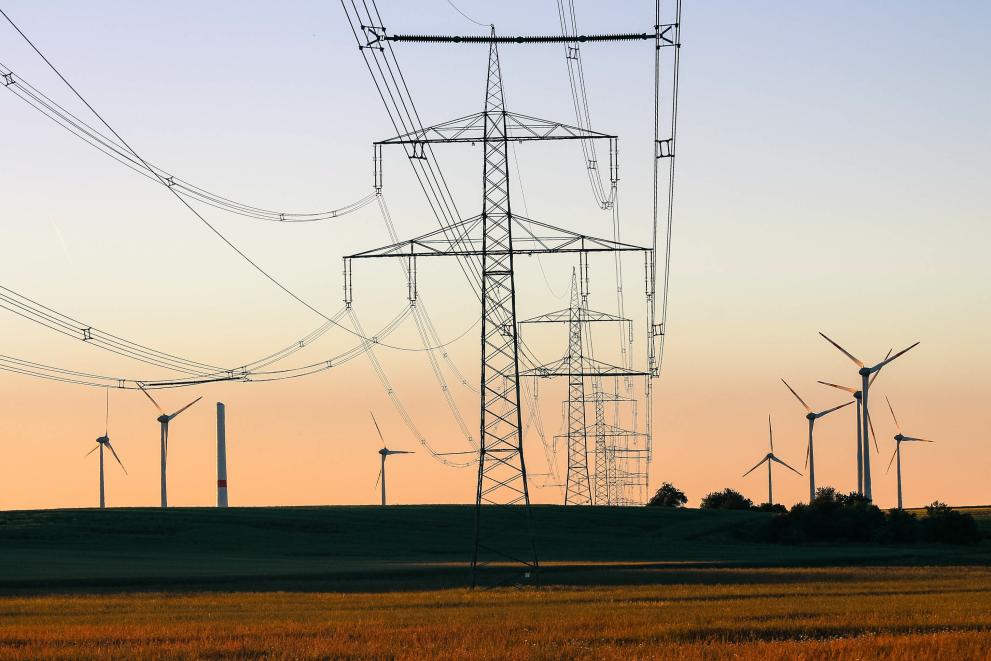
An integrated EU energy market is the most cost-effective way to ensure secure, sustainable and affordable energy supplies to EU citizens.
Through common energy market rules and cross-border infrastructure, energy can be produced in one EU country and delivered to consumers in another.
Boosting competition, improving the long-term markets and allowing consumers to choose energy suppliers keeps prices in check.
EU electricity market
The share of electricity produced by renewable energy sources, predominantly solar and wind, is expected to grow from 37% in 2020 to more than 60% by 2030. In 2022, renewables made up 41.2% of EU’s gross electricity consumption according to Eurostat. At the same time, electricity must also be produced and delivered in sufficient quantities when there is no wind or sun.
Markets need to adapt to better integrate renewable energies and attract investment in fossil-free flexible technologies, such as demand side response and energy storage, that can complement variable energy production. They must also provide the right incentives for consumers to become more active and contribute to keeping the electricity system stable.
The EU electricity market needs to be transparent and efficiently monitored to ensure open and fair competition and protect against market abuse and manipulation. 2022 saw high and volatile energy prices and serious concerns about security of supply and EU heads of government called on the Commission to work swiftly on the structural reform of the electricity market to help Europe secure its energy sovereignty and achieve climate neutrality.
Reform of the electricity market design

To boost renewables, better protect consumers and enhance industrial competitiveness, the Commission proposed a reform of the current electricity market rules in March 2023, as part of the Green Deal Industrial Plan.
The new electricity market design rules consist of the amending Directive EU/2024/1711 and the amending Regulation EU/2024/1747. They were adopted on 21 May 2024 and entered into force on 16 July 2024.
The new rules amend the following pieces of EU legislation
Electricity Directive and Electricity Regulation
The Directive on common rules for the internal market for electricity (EU/2019/944) and the Regulation on the internal market for electricity (EU/2019/943) put the consumer at the centre of the clean energy transition, enabling active participation, with a strong framework for consumer protection. The rules allow more flexibility to accommodate the increasing share of renewable energy in the grid and contribute to the creation of green jobs and growth.
The ACER Regulation
Regulation (EC/713/2009) established the Agency for the Cooperation of Energy Regulators (ACER), and it was recast with Regulation (EU) 2019/942 as part of the Clean energy for all Europeans package.
ACER acts as an independent body to foster the integration and completion of the European internal energy market for electricity and natural gas. The agency’s tasks include, among others, the coordination of actions of national energy regulators at European level (including taking binding decisions in case national regulators cannot agree), the development of common network and market rules, the participation in regional and cross-regional initiatives, the monitoring of market activities (including supervision to combat market manipulation to the detriment of other market participants and consumers), or advice to the EU Institutions on trans-European energy infrastructure development or security of supply.
REMIT Regulation
The Wholesale Energy Market Integrity and Transparency (REMIT) Regulation (EU/1227/2011) ensures that consumers and other market participants can have confidence in the integrity of electricity and natural gas markets, that prices are fair and competitive based on supply and demand, and that no profits can be drawn from market abuse.
Revised Renewable Energy Directive
The more flexible the energy system is, with generation that can rapidly turn on or off, storage that can absorb or put power onto the system, or responsive consumers who can increase or decrease their demand for power, the more stable prices can be and the more renewable energy the system can integrate. The Renewables Directive (EU/2018/2001) was already amended by Directive (EU/2023/2413) whcih entered into force on 20 November 2023.
The Regulation on risk preparedness in the electricity sector (EU/2019/941) is also part of EU Electricity Market Design, but is not concerned by the reform. It requires EU countries to prepare plans for potential future electricity crises, putting the appropriate tools in place to prevent, prepare for and manage these situations. It also requires that EU countries - using common methods - identify all possible electricity crisis scenarios at national and regional levels and prepare risk preparedness plans based on these scenarios. Above all, this preparation requires EU countries to cooperate and coordinate in a spirit of solidarity. It also establishes a framework for more systematic monitoring of security of supply issues via the Electricity Coordination Group.
Reform objectives
The revised rules aim to make the EU energy market more resilient and the energy bills of European consumers and companies more independent from the short-term market price of electricity. This can be achieved by using long-term contracts, such as power purchase agreements and structuring investment support with 2-way contracts for difference.
The reform will also help accelerate the deployment and integration of more renewable energy sources in the energy system, and enhance protection against market manipulation, promoting the stability and predictability of energy prices and thereby contributing to the competitiveness of EU industry.
This will be achieved by introducing a new enforcement regime with an enhanced role for the Agency for the Cooperation of Energy Regulators (ACER) in cross-border investigations, allowing it to pursue important cross-border cases with the most significant impact on the markets.
The reform will also enhance the supervision of reporting parties and data sharing between relevant authorities, increase market transparency through a liquified natural gas (LNG) price assessment and benchmark and ensure more effective enforcement towards non-EU companies, who will have to designate a representative in the EU.
Process timeline
- 21 May 2024
Adoption of the Electricity Market reform (Directive (EU) 2024/1711 and Regulation (EU) 2024/1747)
- 14 December 2023
- 16 November 2023
Energy pricing models
As in other sectors, the EU electricity market includes a number of different players in the supply chain – from producers to suppliers, to end-consumers - with wholesale prices at one end of the supply chain and end-user prices at the other.
The wholesale market in the EU is a system of marginal pricing, also known as a pay-as-clear market, where all electricity generators get the same price for the power they are selling at a given moment. Electricity producers (from national utilities to individuals who generate their own renewable energy and sell into the grid) bid into the market: they establish their price according to their production cost. Renewable energy sources are produced at zero cost and are therefore by definition always the cheapest. The bidding goes from the cheapest to most the expensive energy source. The cheapest electricity is bought first, next offers in line follow. Once the full demand is satisfied, everybody obtains the price of the last producer from which electricity was bought.
This model provides efficiency, transparency and incentives to keep costs as low as possible. There is general consensus that the marginal model is the most efficient for liberalised electricity markets. In fact, it was used by most EU countries before being anchored in EU legislation.
The alternative would not provide cheaper prices. In the pay-as-bid model, producers (including cheap renewables) would simply bid at the price they expect the market to clear, not at zero or at their generation costs.
Overall, it is better for consumers to have a transparent model that reveals the true costs of energy and provides incentives for individuals to become active in generating their own electricity.
Related links
- 21/5/2024 - Electricity Market Design reform formally adopted: Press release | Questions and Answers
- 14/3/2023 - Commission proposal for a Electricity Market Design reform: Press release, Questions & Answers, Factsheet
- 23/1/2023 - Press release: Electricity Market Design – consultation on new reform
- Electricity Market reform (Directive (EU) 2024/1711 and Regulation (EU) 2024/1747)
- Proposal on the revision of the Electricity Market Design and REMIT (COM/2023/148)
- Proposal on the revision of EU’s protection against market manipulation in the wholesale energy market rules (COM/2023/147)
- Study: The future electricity intraday market design (February 2019)
- Regulation on risk-preparedness in the electricity sector (EU/2019/941)
- Regulation establishing a European Union Agency for the Cooperation of Energy Regulators (EU/2019/942)
- Regulation on the internal market for electricity (EU/2019/943)
- Directive on common rules for the internal market for electricity (EU/2019/944)
- Regulation on wholesale energy market integrity and transparency (EU/1227/2011)
